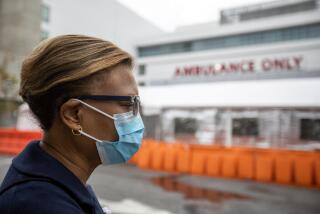Added Burden for County : Emergency Care Cutbacks Stir Fear of More Deaths
- Share via
Next week’s cutback in emergency room services at three downtown Los Angeles hospitals threatens to trigger an increase in deaths and worsen already substandard care at the county’s public hospitals, the medical director of Martin Luther King Jr./Drew Medical Center warned Wednesday.
Rescue ambulances that take an average of 1,200 patients a month to the three private hospitals will be rerouted to King and to County-USC Medical Center, a decision that has prompted outcries from the medical directors of both facilities.
“The perceived elasticity of the Los Angeles County hospital system is a mirage,” said Dr. James Haughton, King’s medical director. “This is a joke,” he said of a contingency plan the hospital has drafted for dealing with the impending crunch. “We’re spitting in the wind.”
Saying that he would be “derelict” if he did not sound the alarm, Haughton said the hospital is already swamped and, therefore, “we are doing some bad things to patients.”
At King, he pointed out, there is only one functioning heart defibrillator in the emergency room and no ultrasound machine for pregnant women.
The operating microscopes used by doctors during brain surgery, he said, are so old that they commonly fall apart in the middle of surgery. The intensive care units are so jammed that heart attack victims and other critically ill patients sometimes languish for days in the emergency room, waiting for an open bed.
To make matters worse, he said, about a third of the registered nursing positions are vacant because salaries are too low to attract candidates for the jobs.
“Last Thursday,” Haughton said, “we had 404 patients and we’re budgeted for 340 beds.”
The crush of sick patients--most of whom enter the hospital through its emergency room--put such a stress on the facility that Haughton closed the emergency room to rescue ambulances for five consecutive days, through Tuesday, and canceled most elective surgery.
“I don’t think there’s any doubt,” Haughton said, that patients have already died for lack of adequate care. “It’s inevitable,” he added, that further overloading the hospital will lead to more deaths.
Dr. Sol Bernstein, medical director of the 1,860-bed County-USC Medical Center, said, “We are dealing with a very, very dangerous situation.”
He described County-USC as “an already burdened system,” that will feel the added crunch during summer--a particularly busy time of the year--and amid a nursing shortage that will further compound the problem.
“It makes for a situation that is more hazardous than when just a couple of trauma centers closed, which was bad enough,” he said.
Negotiations Continue
Haughton and Bernstein expressed their concerns in interviews this week with The Times as top county health officials continued to negotiate with the private nonprofit hospitals to postpone the emergency room cutbacks at least until July 1.
Meanwhile, public interest attorneys said they are poised to seek a restraining order barring curtailment of emergency room services at the three hospitals, California Medical Center, the Hospital of the Good Samaritan and French Hospital of Los Angeles.
Hospital officials said their emergency rooms have become enormous financial drains due to rising numbers of patients unwilling or unable to pay their bills. Several hospitals have given strong indications that they, too, may soon downgrade their emergency rooms to “standby” status--meaning that rescue ambulances would be diverted elsewhere and that doctors would be “on call” rather than on the premises.
In an effort to prevent a domino effect among the private hospitals, Robert C. Gates, Los Angeles County health services director, said that King and County-USC will take the bulk of the additional ambulance traffic generated by private hospital emergency room cutbacks.
But doctors and other health care experts said that the county’s six public hospitals are already stretched to their limit and ill-equipped to handle additional stress. Officials at King and County-USC say the medical centers will need a total of $6 million for additional staffing and equipment to handle what Gates has said will probably be a 40% increase in ambulance traffic.
“We’re going to rupture. We’re going to get massacred,” predicted Clay Cordinas, a licensed vocational nurse at County-USC.
Cordinas works in a special 18-bed “holding” area of the hospital where patients are sent after being treated in the emergency room. But Cordinas said there are commonly more than 30 patients “piled up all over the place” waiting “for several days at a time” for an empty bed in the hospital’s medical intensive care unit.
At various points during the last six months, he said, the area has been so crowded with heart attack victims, gastrointestinal bleeders, and victims of drug overdoses, diabetic comas and AIDS that doctors could not physically reach their patients to treat them.
At King, Haughton said, there is no comparable holding area for critically ill patients like these, so they “back up into the emergency room” where the ratio of nurses to patients is far below what is needed to provide intensive care.
“I went down to the emergency room one night two months ago,” he said, “and found eight patients on monitors plus some on ventilators . . . who should have been in a critical or intermediate care unit,” but there were no beds available there.
Problems Detailed
A year ago, a report compiled by public health researchers concluded that the county’s hospital emergency rooms at that time were seriously “overcrowded and understaffed.” About 400,000 patients a year were estimated to have sought treatment in the emergency rooms of four public hospitals including King and County-USC.
Among the individual horror stories cited by the author, Geraldine Dallek, were cases of patients waiting 30 minutes in ambulances to be unloaded onto emergency room gurneys. Other patients were said to have languished three days or more in county emergency rooms, waiting to be admitted to a hospital bed.
Dallek said Wednesday that she found the emergency rooms to be “harrowing” and predicted that additional ambulances will make them “war zones.”
Her report found that a chronic shortage of nurses was a key problem that has worsened recently.
Both Bernstein and Haughton said that shortage of acute care nurses has prevented the hospital from operating intensive care units at capacity. Often ICU beds go empty--not for lack of patients but for lack of nurses, they said. This restriction clogs up the whole hospital system, preventing doctors from expeditiously moving patients out of the emergency room. And furthermore, Haughton said, the backup can prove lethal to ailing patients.
A key problem, which has worsened since then, was reported to be “a chronic shortage of nurses.”
“We’re already in trouble here,” Haughton concluded. “And we can’t sit here and pretend that just by preparing a contingency plan, we’ll be able to absorb” an additional patient load.
More to Read
Sign up for Essential California
The most important California stories and recommendations in your inbox every morning.
You may occasionally receive promotional content from the Los Angeles Times.













